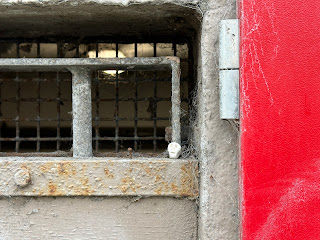It was one of those days made for walking, cool and sunny with no wind. So, I jumped on a train and headed over to Kirkcaldy, a town in Fife. I have always meant to do a bit of exploring around Kirkcaldy, as I don’t think I’ve had a serious wander about there since I was in my early teens. All I can really remember from then is going to a swimming pool somewhere near the sea front, and that there was a big ugly shopping centre, now demolished. There was also a café, which may have been part of the swimming pool complex, that had a really good jukebox. I have memories of drinking cups of tea to Bowie, Blondie, The Undertones, and lots of other stuff that blew my mind at that age.
Arriving
in Kirkcaldy, I wandered down through the town, down the High Street to the
seafront. Though lively, the town seemed
almost to have a bit of a split personality with trendy sushi places and cafés
sitting next to run down looking betting shops, charity shops, bargain shops
and derelict buildings. The town centre is
one of those places full of potential and screaming out for a bit of investment. Maybe one day it will get some.
Wandering
along the seafront I passed by old industrial buildings, new industrial buildings,
and a few rather bland housing estates. After
cutting down by a rather ancient graveyard I ended up on the beach along from
the castle at Ravenscraig, and just down from Ravenscraig Park. There I spotted a small turret on a wall
reaching out towards the sea. It looked
like it should be part of some grand Disney style castle, so intrigued I decided
to go and explore.
Leaving the beach, I wandered up some stairs past an old Doocot and moseyed on to the little tower. There was no castle, just this little turret on the curve of a sea wall. It was nothing more than at attractive little folly to add a bit of interest to the wall. The wall that runs around Ravenscraig Park and overlooks the Forth. The park was originally part of the grounds of Dysart House and was gifted to the people of Kirkcaldy in 1929 by Sir Michael Nairn, an industrialist who owned several linoleum factories in the area.
The
Lookout Tower was built in the early 19th Century, it serves no real
purpose and was built as a folly or a gazebo.
It is however quite an aesthetically pleasing little building,
especially when viewed from the beach.
After
taking in the views, I left the Skulferatu that had accompanied me, in a gap in
the wall by the tower.
The
coordinates for the location of the Skulferatu are -
what3words:
decent.orange.reduce
I
used the following sources for information on the Coastal Turret –




































